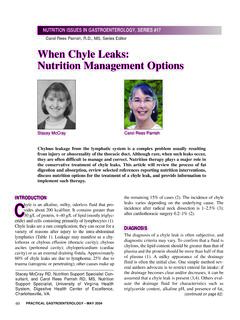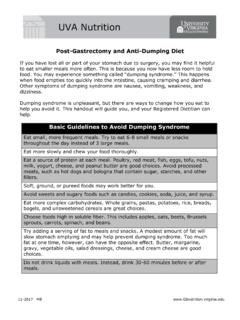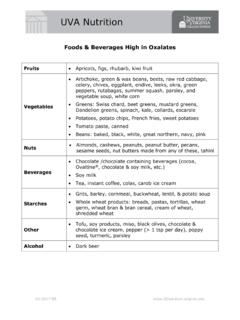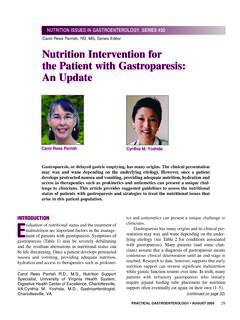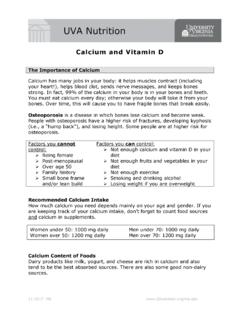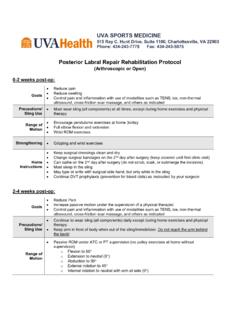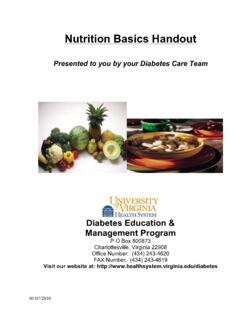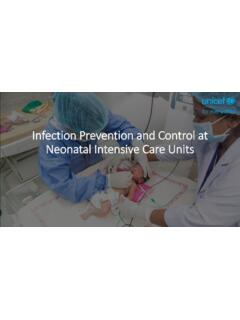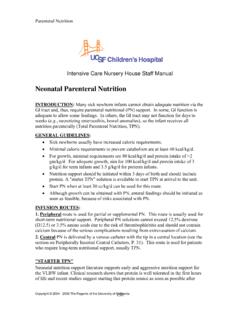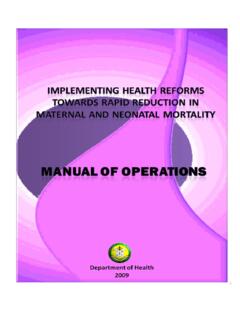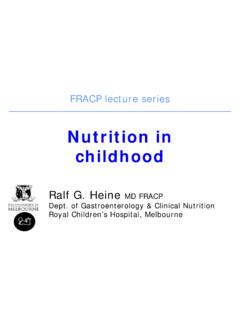Transcription of Cyclic Parenteral Nutrition Infusion: Considerations for ...
1 PRACTICAL GASTROENTEROLOGY JULY 201111 BACKGROUNDP arenteral Nutrition (PN), the intravenous provi-sion of nutrients, may be indicated in patientsexhibiting a wide range of disease states that ren-der enteral Nutrition impossible or inadequate. PN istypically initiated as a continuous, 24 hour , when PN is indicated long term and/oradministered on an outpatient basis, continuous infu-sion poses some important practical obstacles topatients and their caregivers. Foremost, it requires thatpatients be continuously connected to infusion equip-ment that, at best, may interfere with daily activities,and at worst may perpetually immobilize the address this, PN administration on a Cyclic , discon-tinuous basis has been widely employed to providepatients a post-infusion period when infusion equip-ment may be temporarily PN infusion regimens vary widely, butthere are some common features.
2 PN is typicallyadministered as a single 10 14 hour infusion, althoughCyclic Parenteral Nutrition Infusion: Considerations for the ClinicianNUTRITION ISSUES IN GASTROENTEROLOGY, SERIES #97 Stephen Marc Stout, PharmD, MS, BCPS, Pharmaco-therapy Specialist, Metabolism, Interactions, &Genomics Group, Lexicomp, Inc. M. Petrea Cober,PharmD, BCNSP, Clinical Pharmacy Coordinator neonatal Intensive Care Unit, Akron Children sHospital, Assistant Professor of Pharmacy Practice,Northeastern Ohio Medical Rees Parrish, , , Series EditorParenteral Nutrition (PN) is typically administered as a 24 hour infusion in acutely illpatients and those requiring only short term PN.
3 Stable patients who require long termor home PN, however, may benefit from a Cyclic infusion regimen. Cyclic PN infusioninvolves daily interruption of PN, allowing patients periodic freedom from infusionequipment. Daily starting and stopping of PN infusion may increase the risk of hyper-glycemia and hypoglycemia, respectively. Symptomatic post-infusion hypoglycemia isuncommon in adults, but infusion tapering may be warranted in children <2 3 yearsold to limit risk. Critically ill, mechanically ventilated patients may not be candidatesfor Cyclic PN infusion based on increases in energy expenditure and carbon dioxideelimination, among other Considerations .
4 Metabolic consequences of Cyclic PN infusionare reviewed here. M. Petrea CoberStephen Marc StoutPRACTICAL GASTROENTEROLOGY JULY 201112 Nutrition ISSUES IN GASTROENTEROLOGY, SERIES #97 Cyclic Parenteral Nutrition Infusionthis duration may range anywhere from 8 23 hours. Itis common for PN to run overnight for patient conve-nience, particularly when administered at infusion initiation and discontinuation for-mulas exist, and regimens may involve abrupt startingand stopping at the maximum infusion rate, or gradualincreases to/tapering from the maximum rate over agiven period of time (usually up to 2 hours).
5 Thedemonstrated effects of these practices are reviewedbelow. PN components are typically administeredsimultaneously. While Cyclic PN infusion poses clear practicaladvantages over continuous infusion for patientsreceiving PN long-term or at home, the potential metabolic changes that may result from the modifiedpattern of nutrient provision require a metabolic standpoint, there are three key fea-tures that may differentiate Cyclic PN infusion fromcontinuous infusion. First, it requires daily starting andstopping of infusions, during which time the bodymust adapt to changes in blood nutrients.
6 Second, itrequires higher nutrient infusion rates to supply a sim-ilar nutrient load over a shorter period of time. Third,it introduces a post-infusion period when no nutrientsare infused. This review was undertaken to synthesizeevidence of the metabolic consequences of Cyclic PN infusion, for both Nutrition support and REVIEWThe following is a review of prospective studiesdescribing metabolic consequences of Cyclic PN infu-sion. Major metabolic findings are also summarized inTable 1. Infusion Initiation, Discontinuation, and Rate EffectsInfusion of PN in adults and children is associated witha rise in blood glucose concentrations, which return tobaseline within 1 2 hours after infusion discontinua-tion (1 5).
7 Correspondingly, insulin concentrationsrise rapidly following infusion initiation and fallrapidly following discontinuation (1 3,5). Insulin andmaximum blood glucose concentrations appear to risein a dose dependent manner with the rate of PN infu-sion (1,2), and are therefore expected to be greater dur-ing Cyclic infusion than during continuous , when blood glucose elevations occur in sta-ble PN recipients they are generally moderate(<180 200 mg/dL), even with very high dextrose infu-sion rates (1 5).
8 Greater elevations in patients initiat-ing Cyclic PN infusion may signal a need for moregradual shortening of infusion duration and/or admin-istration of exogenous insulin. The risk of persistenthyperglycemia during infusion likely rises withincreasing PN infusion rate (1,2), and diabetic patientsmay be particularly susceptible to PN induced bloodglucose elevations (4). Abrupt initiation of PN infusion in adults causeselevations in blood glucose concentrations that reach asteady state after 60 90 minutes (4).
9 Direct compar-isons to more gradual introduction have not beenmade. Abrupt discontinuation of PN infusion in adultscauses a decrease in blood glucose, primarily in thefirst hour after cessation (3,4,6,7). The minimum bloodglucose concentration, however, is similar to tapereddiscontinuation (6,7), as is the pattern of insulin andcounterregulatory hormone (epinephrine, norepineph-rine, glucagon, growth hormone, and cortisol) concen-trations (6). Symptoms of hypoglycemia have not beenreported in the cited studies of abrupt PN discontinua-tion in adults (3,4,6,7).
10 In contrast to adults, abrupt discontinuation of PNinfusion in children has been associated with elevatedrates of hypoglycemia compared to tapering of theinfusion over 1 hour (8). Notably, this effect wasobserved in one study of 11 children <3 years old, butnot in another study of 15 children 2 11 years old(mean years) (5,8). In the study of children <3years old, abrupt discontinuation was associated withhypoglycemia (defined as blood glucose <40 mg/dL)in 6/11 cases, in children ranging in age from 36months, compared to 2/10 cases when infusion wastapered (8).
